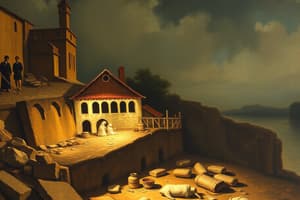Podcast
Questions and Answers
What is the main focus of microeconomics?
What is the main focus of microeconomics?
- Macro-level policies and regulations
- National income and economic growth
- The aggregate behavior of the economy
- The behavior of individual agents like households and firms (correct)
Which concept represents the value of the next best alternative forgone when a choice is made?
Which concept represents the value of the next best alternative forgone when a choice is made?
- Opportunity Cost (correct)
- Supply and Demand
- Scarcity
- Market Equilibrium
What occurs at the point of market equilibrium?
What occurs at the point of market equilibrium?
- Prices are fixed and unchanging
- Demand exceeds supply
- Supply and demand are balanced (correct)
- Supply exceeds demand
Which market structure is characterized by many buyers and sellers, homogeneous products, and free entry and exit?
Which market structure is characterized by many buyers and sellers, homogeneous products, and free entry and exit?
Which factor is likely to influence the demand for a product?
Which factor is likely to influence the demand for a product?
What does elasticity of demand measure?
What does elasticity of demand measure?
In which market structure do a few large firms have significant influence over pricing?
In which market structure do a few large firms have significant influence over pricing?
What is scarcity in economics?
What is scarcity in economics?
What does Gross Domestic Product (GDP) measure?
What does Gross Domestic Product (GDP) measure?
Which of the following best defines inflation?
Which of the following best defines inflation?
What is considered a characteristic of capitalism?
What is considered a characteristic of capitalism?
In economic terms, what does protectionism refer to?
In economic terms, what does protectionism refer to?
Which economic system is characterized by social ownership of production?
Which economic system is characterized by social ownership of production?
Economic models are primarily used for what purpose?
Economic models are primarily used for what purpose?
What does comparative advantage refer to in international trade?
What does comparative advantage refer to in international trade?
Which policy involves adjusting interest rates to influence the economy?
Which policy involves adjusting interest rates to influence the economy?
Flashcards
What is Economics?
What is Economics?
The study of how societies allocate limited resources to satisfy unlimited wants and needs.
What is Microeconomics?
What is Microeconomics?
The branch of economics that focuses on the behavior of individual agents, such as households and firms.
What is Macroeconomics?
What is Macroeconomics?
The branch of economics that examines the aggregate behavior of the overall economy.
What is Scarcity?
What is Scarcity?
Signup and view all the flashcards
What is Opportunity Cost?
What is Opportunity Cost?
Signup and view all the flashcards
What is Supply?
What is Supply?
Signup and view all the flashcards
What is Demand?
What is Demand?
Signup and view all the flashcards
What is Market Equilibrium?
What is Market Equilibrium?
Signup and view all the flashcards
What is Gross Domestic Product (GDP)?
What is Gross Domestic Product (GDP)?
Signup and view all the flashcards
What is inflation?
What is inflation?
Signup and view all the flashcards
What is unemployment?
What is unemployment?
Signup and view all the flashcards
What are business cycles?
What are business cycles?
Signup and view all the flashcards
What is fiscal policy?
What is fiscal policy?
Signup and view all the flashcards
What is monetary policy?
What is monetary policy?
Signup and view all the flashcards
What are economic models?
What are economic models?
Signup and view all the flashcards
What is comparative advantage?
What is comparative advantage?
Signup and view all the flashcards
Study Notes
Introduction to Economics
- Economics is the social science studying how societies allocate scarce resources to satisfy unlimited wants and needs.
- It encompasses two main branches: microeconomics and macroeconomics.
- Microeconomics focuses on individual agents (households and firms).
- Macroeconomics examines overall economy behavior.
- Key concepts include scarcity, opportunity cost, supply and demand, and market equilibrium.
Scarcity and Opportunity Cost
- Scarcity is a fundamental economic problem, limited resources vs. unlimited wants.
- Opportunity cost is the value of the next best alternative forgone.
- Every choice involves trade-offs and a cost of what could have been gained elsewhere.
- Understanding opportunity cost is crucial for individual and societal efficiency.
Supply and Demand
- Supply is the quantity producers offer at various prices.
- Demand is the quantity consumers want to buy at various prices.
- Supply and demand interact to determine price and quantity.
- Supply influencers include input costs, technology, and regulations.
- Demand influencers include consumer preferences, income, and related goods prices.
- Market equilibrium is where supply and demand cross, establishing clearing price and quantity.
Microeconomic Concepts
- Market structures (perfect competition, monopoly, oligopoly, monopolistic competition) impact market behavior.
- Perfect competition is theoretical; many buyers and sellers, homogeneous products, free entry/exit, perfect information.
- Monopoly is one seller with significant price control.
- Oligopoly has a few large firms significantly impacting pricing.
- Monopolistic competition: many firms sell differentiated products.
- Consumer and firm behavior models explain decisions related to consumption, production, and investment.
- Demand and supply elasticity measures responsiveness to price changes.
Macroeconomic Concepts
- Macroeconomics analyzes economic growth, inflation, unemployment, and business cycles.
- Gross Domestic Product (GDP) measures total final goods/services produced within a country.
- Inflation is a general increase in price levels.
- Unemployment is the percentage of the labor force actively seeking work but not employed.
- Business cycles involve fluctuations in economic activity (expansion and contraction).
- Fiscal policy uses government spending and taxation to influence the economy.
- Monetary policy adjusts interest rates and money supply to affect aggregate demand.
- Economic indicators (inflation, unemployment, GDP) monitor economic health and stability.
Economic Systems
- Economic systems (capitalism, socialism, mixed economies) determine resource allocation.
- Capitalism: private ownership, free markets, and profit motive.
- Socialism: social ownership, centralized planning, distribution.
- Mixed economies combine market and planned approaches.
- Government roles differ significantly across systems.
International Economics
- International trade involves exchanging goods/services across borders.
- Comparative advantage is producing a good/service at a lower opportunity cost.
- Trade benefits all participants by allowing specialization and efficiency.
- Protectionism and globalization are key considerations.
Economic Models
- Economic models simplify reality to analyze phenomena.
- Models aid understanding economic relationships and predict reactions to changes.
- Assumptions and simplifications focus on key factors and outcomes.
- Examples include aggregate demand-aggregate supply (AD-AS) models and Phillips curves (inflation-unemployment trade-offs).
Studying That Suits You
Use AI to generate personalized quizzes and flashcards to suit your learning preferences.




